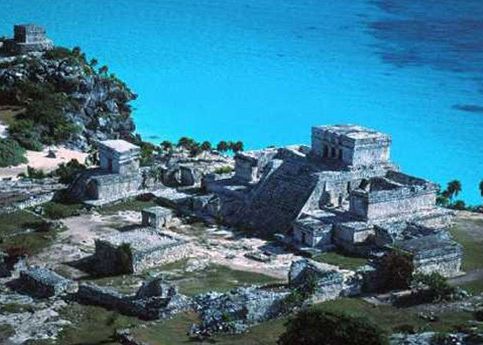Tulum

Situated on the Yucatan Peninsula, Tulum is a Pre-Columbian city. It is often included in LDS tour packages as a Book of Mormon site—locations believed to be connected somehow with places mentioned in the Book of Mormon. Archaeologists have long known about Tulum and there has been archaeological research of the area carried out by professional archaeologists. "All structural and ceramic evidence at Tulúm, as well as its important corpus of murals and relief sculpture, date from the Middle and Late Postclassic (AD 1200-1520)." (Athena Review Vol. 2, No. 1, "Maya sites in Quintana Roo: Tulúm")
Sometimes tours try to convince people that the city is older than it really is, playing up the link to the ancient inhabitants mentioned in the Book of Mormon by trying to tie-in an old stele found there. However, archaeologists say that "Stela 1, found at Tulúm by Stephens and Catherwood in 1843 with an Early Classic date of 9.6.10.0.0 (AD 564), probably came to Tulúm from nearby Xelhá. Another reused stela of AD 761 (9.16.10.0.0) originated only a few km to the north at Tancah..." ("Maya sites in Quintana Roo: Tulúm")
One of the more interesting artifacts for tourists is the "Diving God," or "Descending God." Tour guides catering to LDS clientele often tell the tourists it represents Jesus Christ visiting the Book of Mormon people. However, Ancient History Encyclopedia has this to say:
While it has long been held that Tulum is the only temple complex to depict the Descending God, his image has been found elsewhere. Attempts to link him to the figure of Jesus Christ have been dismissed by all reputable scholarly authorities.
"The Temple of the Descending God," Ancient History Encyclopedia.
In addition, archaeologists believe that the Descending God
.…also known at Cobá and Sayil, are commonly thought, based on their apparent antennae and insect-like torsos, to represent the bee gods Ah Muzencab, known from the Madrid Codex.
Athena Review Vol. 2, No. 1, "Maya sites in Quintana Roo: Tulúm"
Another claim made by these touring sites is that Joseph Smith "identified the ancient name of the city of Zion as being Zama" and they say that the Tulum's original name was Zama. However, there are no recorded instances of Joseph Smith making the connection between "Zama" and "Zion." It is not clear where this rumor started, but it wouldn't be surprising if it was a tour guide looking for an extra tip at the hands of an unsuspecting Mormon tourist. (It is this editor's opinion that the tour site making this statement mis-read another tour site's information found at Alma's LDS Tours—see the quote below.)
Most of the sites promoting Tulum as a Book of Mormon site often make grand pronouncements, but they do not have research backing up their claims. An example can be found at this tourism site (archived page - the original link is no longer available)
Here is another tour site's description about Tulum:
For the Church of Jesus Christ of Latter-day Saints, the ceremonial center of Tulum , identified before its discovery by the name Zama, on June 25, 1842, Speaking of John Lloyd Stephens and Frederick Catherwood, Joseph Smith wrote the following in his personal journal: "Messrs. Stephens and Catherwood have succeeded in collecting in the interior of America a large amount of relics of the Nephites, or the ancient inhabitants of America treated of in the Book of Mormon, which relics have recently been landed in New York." (Joseph Smith, History of the Church of Jesus Christ of Latter-day Saints, 7 vols [Salt Lake City: Deseret Book, 1980]., 5:44). The ancient people of Zama could have knowledge of Jesus Christ during his visit to America. Within this ancient temple, which provides evidence of the history of the Lamanites and brings us closer to learning of love and truth.
Perhaps at Tulum you’ll be surprised to see Zama a maya city, Book of Mormon like Setting Perched as a Light House on the Shore The important structures here include the Castillo, a former temple and the Temple of the Frescos with 13th Century wall painting this is the "Garden Tomb" of Book of Mormon Lands for us. Here we find a depiction of a woman giving birth to an "upside down" God. At the Temple of the Frescos, we see a depiction of "laying on of hands" on one of the frescos. You will see hands that are symbolically giving a blessing. The highlight is to see a three-panel series on the three tiered temple. The Center Panel Shows an Upright God, (We simply testify of God the Father). The Left Hand Side Depicts an Upside down God, (We suggest the imagery of the Son of God, coming down to earth). The Third Panel Is Blank, (We just propose, it could represent the Holy Ghost, because he has no body).
"LDS Tours in Cancun – LDS TOURS Tulum City of Zion," Alma's LDS Tours. (Capitalization as found in original.)
It is this editor's opinion that the tour companies catering to the LDS community are preying upon many members' beliefs that the Book of Mormon is a historical document that took place in Mesoamerica and that archaeological ruins exist proving it. We suggest the following sections of MormonThink:



 RSS
RSS